|
Horse Stable Design, Creating a Safe and Healthy Stable
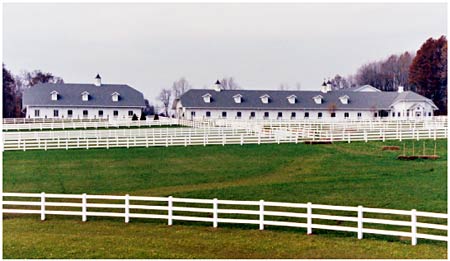 |
Designing a Successful Equestrian Facility from the Horses Perspective.
By Thomas L. Croce –
Before considering the planning and construction of a stable, let’s consider briefly the reasons for providing stables. Nature has provided the horse
in its natural environment the necessary protection from the weather. The thickness of its coat, the natural oils in the skin, and the fact that the animal
may move about freely, are all adequate protection from inclement conditions. A horse living under such conditions, however, is fit only for the lightest of work.
It is only after we interfere in this natural environment that stabling becomes necessary. A horse in full work needs to be fit and kept clean. To
obtain this condition requires the removal of surplus fat, a clipped coat and regular grooming. Thus not only is the coat thinned, but regular cleaning
and grooming take away a large proportion of the coats natural protective oils. Removal of the horse’s natural defense mechanisms necessitates the
implementation of artificial methods of protection, by means of blankets and stables. Stables have, therefore, to provide to a great extent the
protection to the animal which has been removed by the requirements of work and cleanliness. In our efforts to maintain our horses fit and clean we
may be inadvertently overlooking other needs, keeping them safe and healthy. The goal in providing a safe and healthy horse barn is to provide a
barn that is ideally suited for it purpose and minimizes the adverse effects of stabling on our horses. In order to begin to develop an understanding
of how stabling can have adverse effects on our horses lets begin with a discussion on the nature of the horse. First and foremost they are prey
animals with very strong flight instincts. Every aspect of their behavior related to their survival is hardwired to take advantage of their ability to
maintain speed over long distance. Their reliance on other herd members for protection and socialization are all meant to give them a competitive
advantage in quest for survival. Although domesticated horses are not engaged in this daily struggle for survival, these behaviors have been a part of
their psyche for millions of years and are not easily suppressed
The Herd Instinct
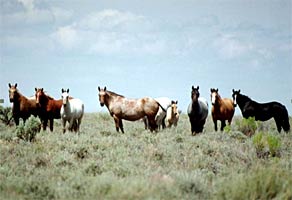 Horses require contact with other horses to allow them to remain calm and relaxed. As herd
animals they rely on other members of the herd for protection, sharing the responsibility for watching for predators. This sharing of the herd defense allows for alternating periods of alertness
and relaxation and creates strong social bonds. An isolated horse is in a constant state of alertness, since he does not have any herd members to share the defense duties. This constant
state of alertness results in much higher stress levels, and can lead to health and behavior problems. Horses require contact with other horses to allow them to remain calm and relaxed. As herd
animals they rely on other members of the herd for protection, sharing the responsibility for watching for predators. This sharing of the herd defense allows for alternating periods of alertness
and relaxation and creates strong social bonds. An isolated horse is in a constant state of alertness, since he does not have any herd members to share the defense duties. This constant
state of alertness results in much higher stress levels, and can lead to health and behavior problems.
Stress
All stabled horses are subjected to stress, and just like us they all deal with it in different ways. The signs may be as subtle as leaving a little of their feed unfinished to any number of stereo
typical behaviors, such as head bobbing, weaving, or cribbing. Long term exposure to stress can manifest itself in more insidious ways, such as ulcers and reduction in immune system effectiveness.
Design to Minimize Stress
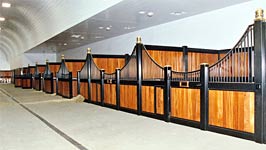 Now that we have reviewed the underlying causes for stress, we can develop planning and design
strategies to minimize the adverse effects of stress on stabled horses. In the planning stage of a project the facility layout should consider the herd dynamic. Horses need to be able to see, smell, and
socialize with other horses. We must also keep in mind that the horse’s range of binocular vision is
very narrow, limiting their range of depth perception, this is the reason they are most comfortable in
the middle of a several hundred acre field, so the area of a stall (as long as it’s large enough to allow comfortable movement) is not as important as the volume of the space. Their need for large open
spaces implies that they will be much more comfortable and relaxed in an open aerie environment,
than in a space that is small and closed in. The design and the construction of the stall should support our efforts to keep your horse safe while
minimizing stress. The stall needs to be considered as a part of a whole system, not just the components of the stall front and partitions (although
they are important as well). The stall system should allow for horses to safely interact with one another, as well as supporting the effort to create an open aerie environment. Now that we have reviewed the underlying causes for stress, we can develop planning and design
strategies to minimize the adverse effects of stress on stabled horses. In the planning stage of a project the facility layout should consider the herd dynamic. Horses need to be able to see, smell, and
socialize with other horses. We must also keep in mind that the horse’s range of binocular vision is
very narrow, limiting their range of depth perception, this is the reason they are most comfortable in
the middle of a several hundred acre field, so the area of a stall (as long as it’s large enough to allow comfortable movement) is not as important as the volume of the space. Their need for large open
spaces implies that they will be much more comfortable and relaxed in an open aerie environment,
than in a space that is small and closed in. The design and the construction of the stall should support our efforts to keep your horse safe while
minimizing stress. The stall needs to be considered as a part of a whole system, not just the components of the stall front and partitions (although
they are important as well). The stall system should allow for horses to safely interact with one another, as well as supporting the effort to create an open aerie environment.
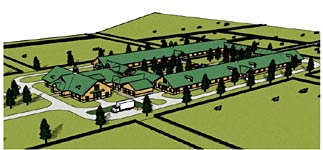 The benefits of creating an environment which considers the horses’ nature can also have
very tangible and practical benefits for horse owners, barn owners and managers. A horse that is more relaxed is more likely to remain healthy due to a stronger immune system, less
likely to suffer from ulcers, colic, and adverse effects of stereo typical behaviors, and be more willing and able to perform the tasks we ask of them. The barn structure is also less
likely to suffer from the effects of a stressed animal by reducing stereo typical behaviors such as cribbing and chewing as well as other damaging behaviors, resulting in less maintenance and repair costs. The benefits of creating an environment which considers the horses’ nature can also have
very tangible and practical benefits for horse owners, barn owners and managers. A horse that is more relaxed is more likely to remain healthy due to a stronger immune system, less
likely to suffer from ulcers, colic, and adverse effects of stereo typical behaviors, and be more willing and able to perform the tasks we ask of them. The barn structure is also less
likely to suffer from the effects of a stressed animal by reducing stereo typical behaviors such as cribbing and chewing as well as other damaging behaviors, resulting in less maintenance and repair costs.
The planning and design of the project is influenced by many other factors as well as minimizing stress, such as safety and health issues, the type of t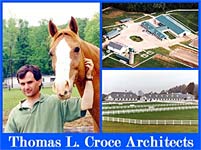 he facility, the type of horse, and the project location. At times one or more of these considerations may be in conflict with each other. Through the
critical evaluation of the many design options an architect with equine expertise will be able to help insure that
your facility not only meets your needs, but helps you in accomplishing your equestrian goals. he facility, the type of horse, and the project location. At times one or more of these considerations may be in conflict with each other. Through the
critical evaluation of the many design options an architect with equine expertise will be able to help insure that
your facility not only meets your needs, but helps you in accomplishing your equestrian goals.
Thomas L Croce Architects Inc.
|